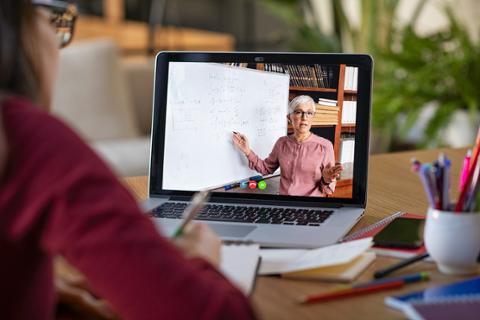The COVID-19 pandemic has upended life for tech students in 2020, bringing changes in how they learn. In parts of the United States, some students are resuming some forms of in-person learning, while others are engaging in a mix of online and classroom studies. For many students, an abrupt pause in on-site learning brings challenges for collaboration—challenges that technology is attempting to solve.
Sketching Software Over Zoom
Kevin Womack was in the last semester of his master’s program in data science at Columbia University in New York City when the pandemic hit. Midway through spring, everyone in his Columbia classes went home, bringing uncertainty about midterms. He had been meeting every day to write code with a partner for his statistical inference class, but now they had to connect remotely and work through time differences, Womack recalled (his colleague was in Seattle, and Womack was home in Tampa).
Before the pandemic, Womack and his classmate would use a pen and paper to sketch out applications they were designing. Later, this work became remote. Holding up a sketch of code on Zoom “isn’t as seamless as you would think,” Womack said. “It was much easier to have those conversations when we were sitting right in front of each other and talking about how we want to put everything together.”
He and his fellow students are now using collaborative tools such as Lucidchart.
After leaving New York in March, Womack is back at Columbia this fall for a capstone project, working with JPMorgan Chase over Zoom on reinforcement learning. The project incorporates machine learning. He will miss the big lunch to introduce the team in person.
Womack and his team have found ways around technical issues such as screen share not working and people talking over each other on Zoom. “I will say I've got a tough group, and we are working through it,” he said.
Keeping Up with Research on Dog Sensors… and Building Masks
Ceara Byrne is in her sixth year of her doctoral program in computer science at Georgia Tech, with a focus in human computer interaction. Like Womack, Byrne misses the in-person collaborative learning with her project groups.
“In person, you have these spontaneous meetups, whereas online you have to be very intentional,” Byrne said.
Byrne and her colleagues use Slack and Microsoft Teams to hold spontaneous meetups, and she has about 10 instant-messaging apps on her phone. In her lab, the team uses Discord, another messaging tool that features text, voice and video. Byrne’s team relies on it to create audio channels and music playlists.
“You could see everyone who is working around the clock just by how much music was being played and when people were engaging,” Byrne said.
Byrne’s doctoral project is to design wearable interactive tools for service dogs. The research involves building sensors and toys for the dogs, along with writing software for printed circuit boards. Moving her work completely online during the pandemic was not an option because she works physically with the dogs.
“We were all terrified because when all of our research shuts down, how do you move forward in a pandemic when all of your research is so physical?” Byrne said.
Meanwhile, Byrne used her experience working with silicone to help build respirator masks. By July 15, she was able to return to the Georgia Tech campus. “I started coming in because if I didn't come in, I would not be able to graduate in May,” she said. “I had to keep moving so that I could finish my dissertation.”
Adjusting to Students' Furlough with More Study Time
Eric Mitchell is a senior at the Tinley Park, Illinois, campus of DeVry University, a for-profit college with locations throughout the United States. Mitchell is studying technical management with a concentration in business intelligence and analytics management. For Mitchell, COVID-19 brought a four-month furlough from his job as a contractor in the IT department at Ford Motor Company in Chicago. Despite the lack of work, the time off was positive because it brought a focus on his studies and his family.
Before the pandemic, Mitchell worked 12 to 14 hours per day, and now he works 8 hours a day, so he has more time for his studies. “The 40 hours have made a dramatic difference rather than working 60-plus hours in one week,” Mitchell said.
“That gave me a chance to just really take this knowledge and skill sets and apply it to the place that I worked so that I could maximize my time,” he added.



